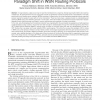Free Online Productivity Tools
i2Speak
i2Symbol
i2OCR
iTex2Img
iWeb2Print
iWeb2Shot
i2Type
iPdf2Split
iPdf2Merge
i2Bopomofo
i2Arabic
i2Style
i2Image
i2PDF
iLatex2Rtf
Sci2ools
COMSUR
2011
2011
From MANET To IETF ROLL Standardization: A Paradigm Shift in WSN Routing Protocols
—In large networks, a data source may not reach the intended sink in a single hop, thereby requiring the traffic to be routed via multiple hops. An optimized choice of such routing path is known to significantly increase the performance of said networks. This holds particularly true for wireless sensor networks (WSNs) consisting of a large amount of miniaturized battery-powered wireless networked sensors required to operate for years with no human intervention. There has hence been a growing interest on understanding and optimizing WSN routing and networking protocols in recent years, where the limited and constrained resources have driven research towards primarily reducing energy consumption, memory requirements and complexity of routing functionalities. To this end, early flooding-based and hierarchical protocols have migrated within the past decade to geographic and self-organizing coordinate-based routing solutions. The former have been brought to standardization through the ...
COMSUR 2011 | Hardware | Internet Engineering Task Force | Reducing Energy Consumption | Wireless Sensor Networks |
| Added | 18 Dec 2011 |
| Updated | 18 Dec 2011 |
| Type | Journal |
| Year | 2011 |
| Where | COMSUR |
| Authors | Thomas Watteyne, Antonella Molinaro, Maria Grazia Richichi, Mischa Dohler |
Comments (0)

